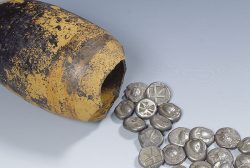The archaeologists Demelena Ladogianni and Giannis Stogias illustrate the cost of food products in the market of Ancient Greece. “The base of the ancient Attica diet during the 4th-3rd century BC consisted of cereals, olive oil, figs, grapes and wine (wine with water). Meat was rarely consumed, especially by the lower social classes since it was distributed to the citizens after sacrifices or feasts or it was sold in exceptional cases in the Market. On the other hand, fish was considered an important factor in the diet of most Greeks in the classical era. They were consumed either salted or dried for the poor while the expensive fresh ones were consumed by the rich. Moreover, vegetables, fruit, nuts, pulses and cereal were adequately consumed. Olive oil was present in most dishes. In Athens, the state undertook the monopoly to export oil production and the profits from the oil and the wine was used to pay the wheat quantities, which the state had to import on a constant basis”.
More particularly, they emphasize that ‘during the same period namely in 363 BC, wheat was sold for 1 Delphic medimnon (74, 16 kilos), 2 Aeginetan drachmas.
Even in 330 BC, 1 Attican medimnon (40, 27 kilos) in Athens was sold 5 Athenian drachmas.
At about 330 BC, 1 Attican medimnon (wheat in Athens) cost 16 Athenian drachmas.
Before 331 BC 1 artavi (or 1 medimnon) of wheat in Egypt cost 10 Alexandrian drachmas.
In 331-323 BC, 1 artavi (or 1 medimnon) of wheat in Egypt was sold 32 Alexandrian drachmas.
In 282 BC, 1 Attican medimnon of wheat in Delos cost 4-10 Attican drachmas.
At about 277 BC, 1 Attican medimnon of wheat in Gazoros cost 2 Attican drachmas, 4 obols.
At about 277 BC, 1 Attican medimnon of barley in Gazoros cost 1 Attican drachma, 4 obols.
Wine in the 4th century BC, 1 hous (about 3, 12 liters) of wine in Athens cost 10 Attican obols.
About 300-210 BC vegetables and spouts (quantity unknown) in Egypt cost 1, 5 Ptolemaic obols.
Meat (pork foot) in the 4th century BC in Athens was sold 1 Attican drachma.
Fish (salted) in the 4th century BC, in Athens cost 5 Attican copper coins.
During the 4th century BC, tarichos a kind of salted fish was sold in Athens for 2 Attican obols.
During the 4th century BC, thunnus (kind of tuna) in Athens cost 1 Attican drachma.
During the late 4th century BC, 1 bass fish in Athens cost 10 Aeginetan obols.
During the 3rd century BC, 1 mna (600-800 g.) of thunnus (kind of tuna) in Delphi cost about 12 Aeginetan copper coins.
During late 3rd century BC, 1 mna of thunnus (kind of tuna) in Viotia cost about 14 Aeginetan copper coins.
During late 3rd century BC, 1 mna of lavrich (lake fish) in Viotia cost about 13 Aeginetan copper coins.
About 335-322 BC the fee regarding food allowance for the Athenian teenager reached the amount of 4 Athenian obols.
In 329-8 BC, the wages of a construction builder in Eleusis was 1 Athenian drachma and 3 obols.
In 314-3 BC, the wages of an Athenian sailor was 4 Athenian obols.
In the early 3rd century BC, the wages of a Lysimachus soldier was 4 Attican obols.
In 282 BC, the wages and the food of a stone craftsman in Delos was 2 Attican obols and 1,5 choinikas of wheat.
During the late 3rd century BC, the wages and the food of a soldier in Crete were 1 Aeginetan drachma and 1 choinikas of wheat’.
The following recipes use the above products.
More specifically:
– Salted fish marinated in wine, olive oil and silfio herb
«…First this fillet of salted tuna in season costs two obols. It should be cleaned very well. Then put the fish in a bowl adding seasoning. Pour white wine and olive oil and boil it till it becomes soft. Garnish with silfio herb».
Alexis, Ponira (Athenaeus, Deipnosophistai, 3,117d).
– Yeast and dough for twelve barley bread
Yeast
1/2 cup (60 g.) barley flour
1 teaspoon of fresh yeast or 1/2 teaspoon dry yeast
Dough
1 1/2 cup (170 g.) whole wheat flour
1 1/2 cup (170 g.) barley flour
1 teaspoon salt
Dissolve the yeast in a spoonful of warm water and use it to make dough with 1/2 cup of barley flour. Knead the dough soon and give it the shape of a ball. Cross it slightly and press your finger on the center. Pour 2 teaspoons of warm water. Put the mixture on a glass tray, cover it and leave it in a warm place for at least 24 hours to be fermented.
In order to prepare the dough: Sift the whole wheat and barley flour together. Add 1 teaspoon of salt as well as the mixture of yeast. Make dough using enough warm water. Knead well and let it rest in a bowl covered with a plastic wrap or a plastic bag till it doubles in size. Divide the dough into 12 pieces and make soft balls. Leave them become bigger in a warm place covered with a cloth.
Heat the oven to 200°C. Heat a baking dish and an overturned pot or a shallow ceramic or a metal pan-whatever you decide to use as “brick baking”. Put some olive oil on the baking dish and place the buns one next to the other in a circular mode formulating two circles that contain 6 buns each. Cover with the overturned pot and bake for 15-20 minutes till they are ready.
ANCIENT GREECE: 4th century BC till 3rd century BC

